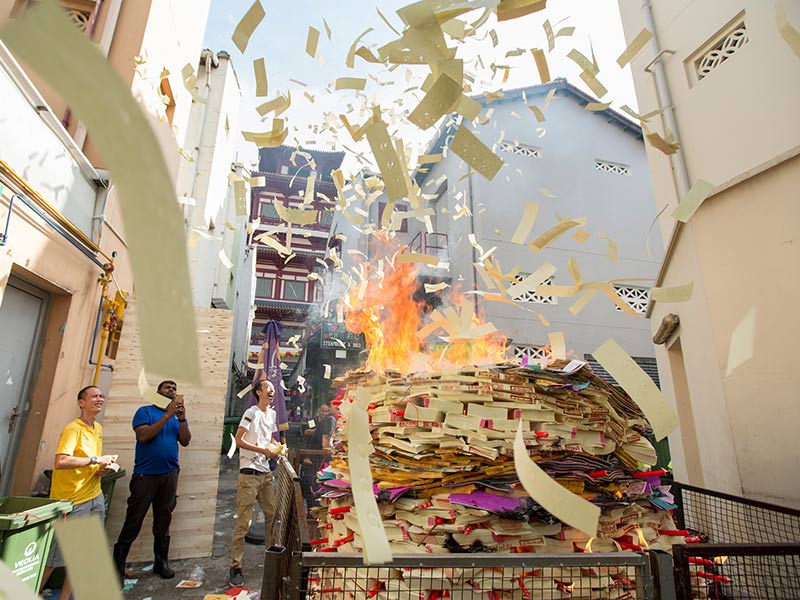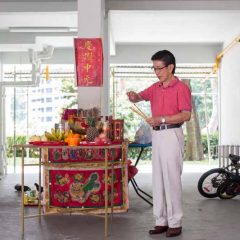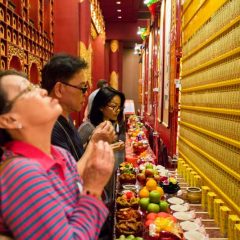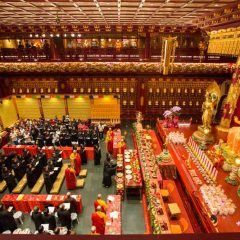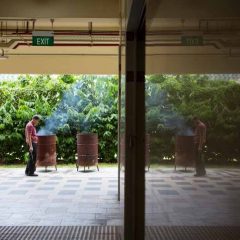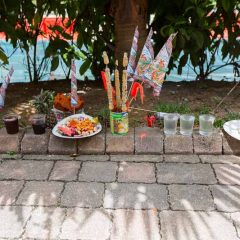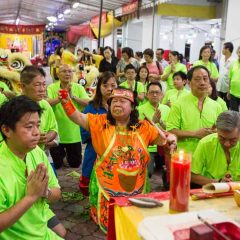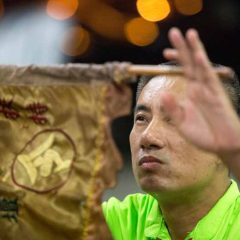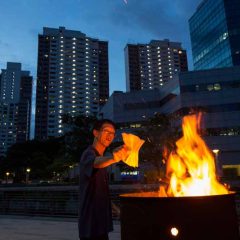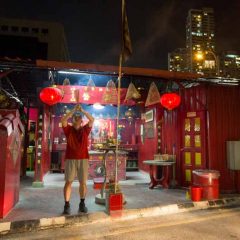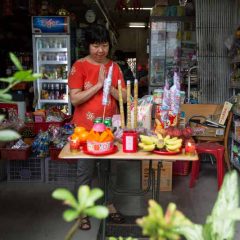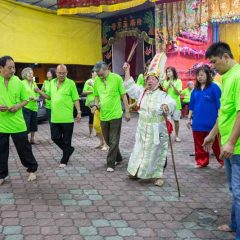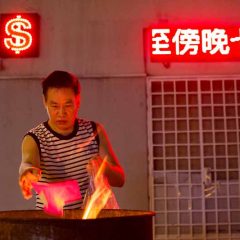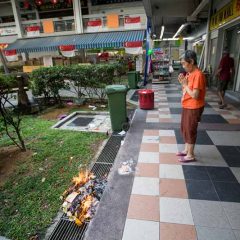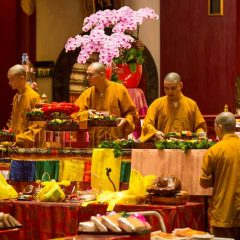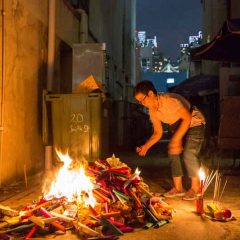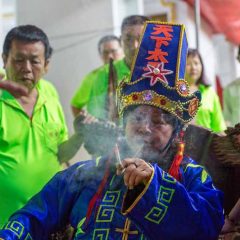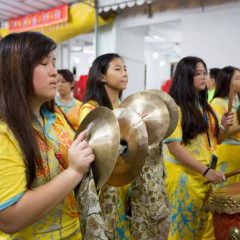SINGAPORE (RNS) — This time of year, the streets of Singapore come alive with celebrations of Hungry Ghost Month.
Buddhists and Taoists throughout Asia believe the gates of hell open during the seventh month on the lunar calendar. The ghosts of the departed come back to visit the living, who have a special opportunity to pray for their departed ancestors, leave them food offerings and perform other rituals to alleviate their sufferings.
The 15th day of Hungry Ghost Month — Sept. 5 in 2017 — is marked by Yu Lan, or the Hungry Ghost Festival.
[ad number=“1”]
“In Singapore the Hungry Ghost Festival traditions represent a mix of Buddhism, Taoism and Chinese folklore,” said Terence Heng, a sociologist at the Singapore Institute of Technology.
Public walkways and green spaces become temporary religious spaces during this time of the year. Believers make roadside offerings and create makeshift altars for spirits that resemble temples.
- A team from a local company burns paper offerings on a back alley in Singapore’s Chinatown during the Hungry Ghost Festival. RNS photo by Alexandra Radu
- A man makes food offerings on a makeshift altar on the ground floor of an apartment in a residential neighborhood of Singapore during the Hungry Ghost Festival. RNS photo by Alexandra Radu
- People pray in front of tables with food offerings at the Buddha Tooth temple in Singapore’s Chinatown during the Hungry Ghost Festival. Above the offerings are rows of papers inscribed with the names of the departed from each family. RNS photo by Alexandra Radu
- Buddhist monks and other believers chant sutras at the Buddha Tooth Relic Temple in Singapore’s Chinatown during the Hungry Ghost Festival. RNS photo by Alexandra Radu
- Ah Ngor, a 61-year-old medium, chews burning joss sticks. Through this ritual, performed during Hungry Ghost Month, she believes she is enhancing her powers as a medium. RNS photo by Alexandra Radu
- People pass in front of tables with food offerings at the Buddha Tooth Relic temple in Singapore’s Chinatown during the Hungry Ghost Festival. RNS photo by Alexandra Radu
- A man burns paper offerings in front of a residential building in Singapore during the Hungry Ghost Festival. RNS photo by Alexandra Radu
- An employee from a local company tosses an offering of paper money in an alley in Singapore’s Chinatown during the Hungry Ghost Festival. RNS photo by Alexandra Radu
- Food offerings are left by the roadside in a residential neighborhood of Singapore during the Hungry Ghost Festival. RNS photo by Alexandra Radu
- Ah Ngor, a 61-year-old medium, prays in a trance surrounded by her followers. She channels Shan Cai Tong Zi, the Chinese child god of wealth. RNS photo by Alexandra Radu
- A follower of a local medium prays during a ceremony during Hungry Ghost Month. RNS photo by Alexandra Radu
- A man burns paper offerings on a sidewalk in a residential neighborhood of Singapore during the Hungry Ghost Festival. RNS photo by Alexandra Radu
- A man prays and burns joss sticks in front of a small temple during the Hungry Ghost Festival. RNS photo by Alexandra Radu
- A woman prays at a makeshift altar with food offerings in front of her shop during the Hungry Ghost Festival. RNS photo by Alexandra Radu
- Ah Ngor, a 61-year-old medium, walks in a trance surrounded by her followers. She channels Tua Ya Pek, one of the two guardian deities of hell. RNS photo by Alexandra Radu
- A man burns paper offerings during the Hungry Ghost Festival. RNS photo by Alexandra Radu
- A woman burns paper offerings during the Hungry Ghost Festival. RNS photo by Alexandra Radu
- Monks at the Buddha Tooth temple in Singapore’s China Town set tables with food offerings. RNS photo by Alexandra Radu
- A woman offers food and burns joss paper on a back alley in Singapore’s China Town during the Hungry Ghost Festival. RNS photo by Alexandra Radu
- Burning joss sticks and candles are left on a sidewalk during the Hungry Ghost Festival. RNS photo by Alexandra Radu
- Ah Ngor, a 61-year-old medium, sits in a trance surrounded by her followers. She channels Di Ya Pek, one of the two guardian deities of hell. RNS photo by Alexandra Radu
- Members of a Chinese traditional orchestra play during a ceremony during the Hungry Ghost Festival. RNS photo by Alexandra Radu
The roots of the festival date back more than 2,000 years ago, when Mulian (or Maudgalyayana), a disciple of the Buddha, had a vision that his mother was suffering in hell. Taking the Buddha’s advice, Mulian organized on the 15th day of the seventh lunar month a ceremony to redeem her soul by giving offerings and chanting sutras — texts of Buddhist scripture.
[ad number=“2”]
Over the millennia, a tradition of offering paper objects developed — paper representations of things departed relatives might need or like that are burned alongside altars with food offerings. In Singapore the objects range from paper money to paper clothing, cars, houses, mobile phones or credit cards.
Individuals and families give offerings, but companies also organize ritual burning in hopes of ensuring prosperity.
For Buddhists and Taoists during Hungry Ghost Month, the line between the realms of the living and dead blurs. It is believed that the short time spent among humans will serve as an incentive for the ghosts to atone and lead better lives in future reincarnations. For the living, it is an opportunity to honor their ancestors.
